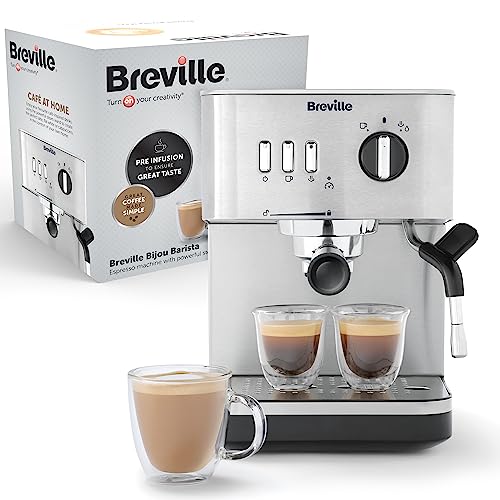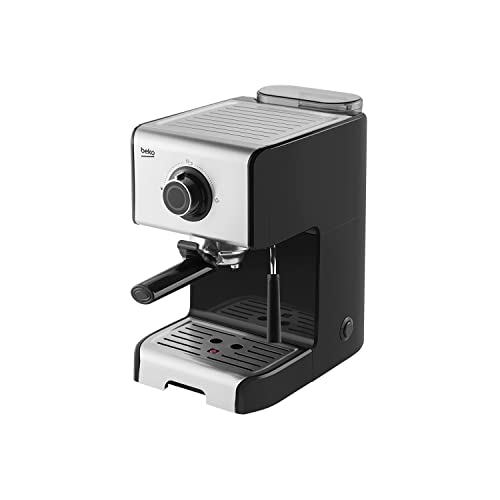9 Lessons Your Parents Teach You About Machine Espresso

Yvette Renteria
2024-11-11 00:34
7
0
본문
How Does Machine Espresso Work?
Machine espresso (coffeee57011.blogripley.com) utilizes precise pressure and mind-blowing filter technology to make the delicious coffee we enjoy. How exactly does it work?
 To make an espresso, hot water is pushed under pressure through finely ground coffee. The process is similar to that of making drip coffee. However, the pressure is the main difference.
To make an espresso, hot water is pushed under pressure through finely ground coffee. The process is similar to that of making drip coffee. However, the pressure is the main difference.
The Group Head
As the name suggests the group head is the place you put your portafilter in when brewing espresso. It disperses water in the portafilter and controls the pressure of the extraction. There are a variety of types of group heads each with its unique advantages and drawbacks. Some are designed to provide stability of temperature while others are specifically designed to handle pre-infusion. Others are built to control the lever. There are some that come with a range of features, such as the E61, which is considered the standard choice for many baristas due to its capacity to provide multiple benefits in a single package.
As you can see in the above image the group head comes with several notches to place your portafilter and then twist it manually to secure it. A gasket made of rubber is positioned inside the notches to help make a seal when you insert your portafilter. The notches permit precise placement of the portafilter. This is essential for an accurate extraction.
The group head does not just allow you to insert your portafilter easily, but it also maintains an even temperature. This is accomplished by cycling hot water around the portafilter and through the brew-basket to ensure that the temperature is at the right level for extraction. This is important, as even a small difference in temperature can be the difference between a good and great espresso coffee machines.
The Pump
In contrast to piston machines that are manually operated, which use a lever to pressurize water, rotary espresso machines rely on motorized pumps bean to cup espresso machine deliver the nine atmospheric bars of pressure that are required to extract espresso. This pressure is generated by pumping water through a heat-exchanger and then through the ground coffee.
Pumps tend to be less expensive than piston-driven machines, and they tend to last longer. However, both types of machines may become damaged due to excessive use and poor cleaning. Pumps are also more complicated mechanically, which can increase the cost of even the simpler models.
Some espresso machines employ steam pressure instead of a pump for brewing espresso. This can lead to over-extraction as the boiler that produces steam also heats the water to boil. Additionally these machines typically have to restore their pressure between cups, which requires time and energy.
Many espresso machines utilize an rotary or vibrating pump, with a vibration model using a vibrating disc to create the pressure and an rotary model that pushes hot water through the grounds at high speed. Both machines can produce excellent espresso but rotary machines are quieter, more durable and less likely to fail.
The Boiler
The boiler is the component that heats the water to the ideal temperature for extraction. The steam produced is then directed to the portafilter, which is the container that holds the espresso coffee espresso machine grounds. It is then pumped into the cup. The steam creates pressure and pushes through the coffee grounds. This results in a crema on top of the espresso. This is a sign of a good espresso.
There are three kinds of espresso and filter coffee machine machines, each having distinct pumps and brew temperature. There are many ways to control the strength of the brew and the size of cup that can be produced by the machine.
The first espresso machines were steam-type. The first espresso machines were steam-type machines. This led to the coffee tasting bitter and burnt. This is why Milanese makers Luigi Bezzerra and Desiderio Pavoni created the modern espresso machine.
The most well-known espresso machine is a semiautomatic that has an electric pump. These are what people imagine when they imagine an espresso machines uk machine. With a semi-automatic espresso machine, you need to grind the beans and tamp them by hand. The pump regulates the flow of water and pressure. This is an excellent combination of human control and mechanised accuracy.
The Filter
Espresso machines typically have filters that separate the grounds of the coffee from the hot water. The filter is also a vital component of the machine's temperature control, since it helps to prevent overheating.
Filters also aid in flavor, as it permits the beans to flower for a longer period of time. This allows beans to release their flavors and provides an opportunity to improve extraction.
However it is crucial to remember that even a high-quality filter can produce a bad cup of coffee, as the quality of the beans and extraction is still vital.
It's here that the magic happens. This is what makes espresso taste so delicious. The grouphead, sometimes referred to as the brew head, is the place where the portafilter (the container you place the ground coffee into) sits when you're making espresso.
Steam-driven espresso machines use hot water that is heated inside an airtight container to produce steam. The steam then pushes hot water into the grounds of the coffee under pressure. These types of machines are typically less expensive and simpler to maintain than pumps-driven models. They are however limited to create the perfect conditions for brewing, as they operate with 1-1.5 bar of pressure. The ideal shot requires 9-10 bars.
 In recent years, compressed air-pump-driven espresso machines have become more popular. They use an air compressor to force hot water through the grounds and are significantly more portable than electric steam-driven machines.
In recent years, compressed air-pump-driven espresso machines have become more popular. They use an air compressor to force hot water through the grounds and are significantly more portable than electric steam-driven machines.
Machine espresso (coffeee57011.blogripley.com) utilizes precise pressure and mind-blowing filter technology to make the delicious coffee we enjoy. How exactly does it work?
 To make an espresso, hot water is pushed under pressure through finely ground coffee. The process is similar to that of making drip coffee. However, the pressure is the main difference.
To make an espresso, hot water is pushed under pressure through finely ground coffee. The process is similar to that of making drip coffee. However, the pressure is the main difference.The Group Head
As the name suggests the group head is the place you put your portafilter in when brewing espresso. It disperses water in the portafilter and controls the pressure of the extraction. There are a variety of types of group heads each with its unique advantages and drawbacks. Some are designed to provide stability of temperature while others are specifically designed to handle pre-infusion. Others are built to control the lever. There are some that come with a range of features, such as the E61, which is considered the standard choice for many baristas due to its capacity to provide multiple benefits in a single package.
As you can see in the above image the group head comes with several notches to place your portafilter and then twist it manually to secure it. A gasket made of rubber is positioned inside the notches to help make a seal when you insert your portafilter. The notches permit precise placement of the portafilter. This is essential for an accurate extraction.
The group head does not just allow you to insert your portafilter easily, but it also maintains an even temperature. This is accomplished by cycling hot water around the portafilter and through the brew-basket to ensure that the temperature is at the right level for extraction. This is important, as even a small difference in temperature can be the difference between a good and great espresso coffee machines.
The Pump
In contrast to piston machines that are manually operated, which use a lever to pressurize water, rotary espresso machines rely on motorized pumps bean to cup espresso machine deliver the nine atmospheric bars of pressure that are required to extract espresso. This pressure is generated by pumping water through a heat-exchanger and then through the ground coffee.
Pumps tend to be less expensive than piston-driven machines, and they tend to last longer. However, both types of machines may become damaged due to excessive use and poor cleaning. Pumps are also more complicated mechanically, which can increase the cost of even the simpler models.
Some espresso machines employ steam pressure instead of a pump for brewing espresso. This can lead to over-extraction as the boiler that produces steam also heats the water to boil. Additionally these machines typically have to restore their pressure between cups, which requires time and energy.
Many espresso machines utilize an rotary or vibrating pump, with a vibration model using a vibrating disc to create the pressure and an rotary model that pushes hot water through the grounds at high speed. Both machines can produce excellent espresso but rotary machines are quieter, more durable and less likely to fail.
The Boiler
The boiler is the component that heats the water to the ideal temperature for extraction. The steam produced is then directed to the portafilter, which is the container that holds the espresso coffee espresso machine grounds. It is then pumped into the cup. The steam creates pressure and pushes through the coffee grounds. This results in a crema on top of the espresso. This is a sign of a good espresso.
There are three kinds of espresso and filter coffee machine machines, each having distinct pumps and brew temperature. There are many ways to control the strength of the brew and the size of cup that can be produced by the machine.
The first espresso machines were steam-type. The first espresso machines were steam-type machines. This led to the coffee tasting bitter and burnt. This is why Milanese makers Luigi Bezzerra and Desiderio Pavoni created the modern espresso machine.
The most well-known espresso machine is a semiautomatic that has an electric pump. These are what people imagine when they imagine an espresso machines uk machine. With a semi-automatic espresso machine, you need to grind the beans and tamp them by hand. The pump regulates the flow of water and pressure. This is an excellent combination of human control and mechanised accuracy.
The Filter
Espresso machines typically have filters that separate the grounds of the coffee from the hot water. The filter is also a vital component of the machine's temperature control, since it helps to prevent overheating.
Filters also aid in flavor, as it permits the beans to flower for a longer period of time. This allows beans to release their flavors and provides an opportunity to improve extraction.
However it is crucial to remember that even a high-quality filter can produce a bad cup of coffee, as the quality of the beans and extraction is still vital.
It's here that the magic happens. This is what makes espresso taste so delicious. The grouphead, sometimes referred to as the brew head, is the place where the portafilter (the container you place the ground coffee into) sits when you're making espresso.
Steam-driven espresso machines use hot water that is heated inside an airtight container to produce steam. The steam then pushes hot water into the grounds of the coffee under pressure. These types of machines are typically less expensive and simpler to maintain than pumps-driven models. They are however limited to create the perfect conditions for brewing, as they operate with 1-1.5 bar of pressure. The ideal shot requires 9-10 bars.
 In recent years, compressed air-pump-driven espresso machines have become more popular. They use an air compressor to force hot water through the grounds and are significantly more portable than electric steam-driven machines.
In recent years, compressed air-pump-driven espresso machines have become more popular. They use an air compressor to force hot water through the grounds and are significantly more portable than electric steam-driven machines.

댓글목록0
댓글 포인트 안내